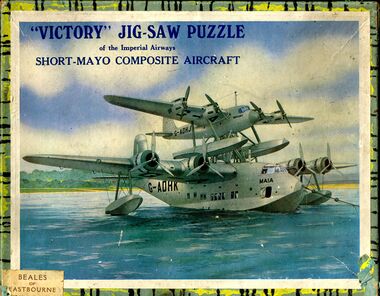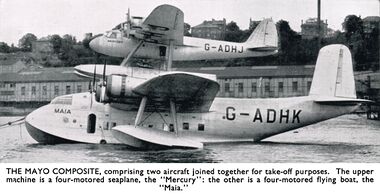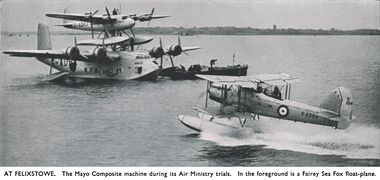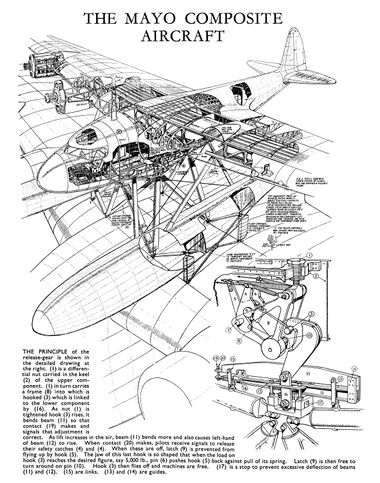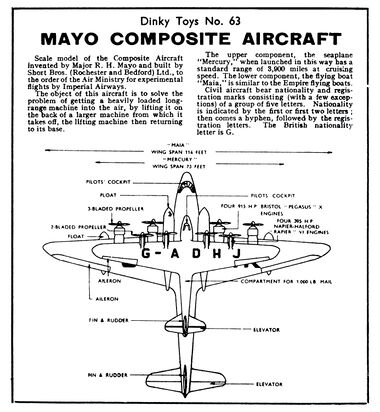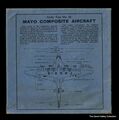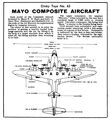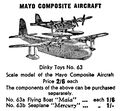Category:Mayo Composite Aircraft
The Mayo Composite Aircraft, as Victory Jigsaw Puzzle M.A.2 [image info]
1938: side view [image info]
1938: Mayo Composite and Fairey Sea Fox, at Felixstowe [image info]
Lineart diagram of the Mayo [image info]
1939: Box lid lineart [image info]
The Short-Mayo Composite Aircraft was the concept of the Technical General Manager at Imperial Airways, Major Robert H. Mayo, and was developed by Mayo with Arthur Gouge, the Short Brothers Chief Designer.
The Mayo Composite was one of those striking innovations of the 1930s that gathered a great deal of attention and seemed to be poised to be part of the future of aviation. As things worked out, this didn't happen: after the Mercury has made its successful transatlantic crossing (and been shipped back), the two-plane concept was pretty much made redundant by the perfection of in-air refuelling (using a hose and a guide nozzle), which gave an alternative method of allowing an aircraft to start crossing the Atlantic at altitude with a full fuel-tank. Although mid-air refuelling was tricky, existing aircraft could be adapted to use it, which couldn't be as easily said of the two-plane approach.
Configuration
The final aircraft consisted of the
- Short S.20 Mercury (G-ADHJ) seaplane, and the .
- Short S.21 Maia Flying Boat (G-ADHK).
The Mercury was theoretically capable of crossing the Atlantic on its own, but with a reduced load in order to have a reasonable takeoff weight, and to also accommodate the fuel needed for the takeoff itself, and for getting to main flight altitude. If it was given an "assisted takeoff" by a big seaplane that could handle the brute force necessary for a fully-laden takeoff, The Mercury would be able to not only start its journey fully-laden, but could also replace the weight of the fuel needed for takeoff and initial climb, with further passengers or freight.
The Maia was recognisably a slightly redesigned version of the Short Empire Flying Boat, with a top structure to attach the Mercury, engines moved to avoid fouling the Mercury's floats, and sidewalls that curved outward at the bottom, to allow a greater lower surface area for hydroplaning at takeoff, to support the greater takeoff weight.
1937 description:
The Short-Mayo so-called "composite" aircraft is based on the principle of a large flying boat ascending with a smaller long-range, heavily-loaded seaplane mounted on its upper structure. The latter is fitted with four Napier "Rapier" engines giving a total of some 1,300 h.p. and the former (the lower component) is provided with four Bristol "Pegasus X" engines developing about 3,250 h.p. The purpose of the large flying boat is, of course, to assist the smaller aircraft — which is designed for the ocean transport of mails and will be very heavily loaded — into the air, and it is hoped that it will be possible by this method to carry much larger loads on the Atlantic route and at higher speeds — but with the expenditure of less power — than would be possible by employing the ordinary method of ascending unaided from the surface of land or sea. As soon as the required operating altitude has been reached the aircraft separate and the flying boat returns to its port. Other experiments are, at the time of writing, being undertaken by the German company Lufthansa with flying boats fitted with Diesel engines using a new form of non-inflammable fuel. The advantages of such a power unit are that the weight of fuel carried is slightly less and the risk of fire resulting from a bad landing or other cause is much reduced.
— , M.J.B. Davy, , Interpretative History of Flight, , 1937
1938 description:
The Short-Mayo Composite Aircraft
Seaplane Launched from a Flying Boat
ONE of the greatest difficulties met with in the operation of long range commercial aircraft is the launching of a heavily-laden machine, encumbered, as it must necessarily be, by its cargo of freight or passengers and its weighty tanks of fuel. Once a successful take-off has been achieved, the load can be carried with ease, but the problem of attaining the desired air speed and height is difficult to solve. The recently-built Short-Mayo Composite aircraft, which has now successfully completed its preliminary tests, surmounts the difficulty by the ingenious principle of launching a seaplane, which carries out the flight, from a larger "assisting" flying boat after the two have taken off as a combined unit and climbed to a certain height.
It is not the first time that the method has been tried, for in 1916 a Bristol "Bullet" was launched from the upper wing of a "Baby Porte" flying boat. The Short-Mayo, however, is the first scientifically-designed composite aircraft built with the object of launching one aeroplane by combining it with another, and subsequently separating the two when the necessary height and speed have been reached.
The lower part of the Short-Mayo Composite consists of a high wing cantilever monoplane, named "Maia," which closely resembles an Empire flying boat. It has a wing span of 114 ft. and is powered by four Bristol "Pegasus Xc" nine-cylinder radial engines, fitted with three-bladed controllable-pitch airscrews. The engines have a normal output of from 810 h.p. to 850 h.p. at 2,250 r.p.m. at a height of 4,000 ft., and a take-off output of from 920 h.p. to 960 h.p. at 2,475 r.p.m.
Although the "Maia" is primarily constructed for "assister" work, the interior of the hull has two decks of similar form to those of the Empire flying boats, and is provided with three passenger compartments, bunk stowage, pantry, luggage and stowage spaces, and is capable of carrying out flights of a similar kind to those of the Empire aircraft.
The upper component is a four-engined float seaplane named "Mercury." It also is a high wing cantilever monoplane, but naturally is of smaller and lighter construction. Its structure is all-metal, with the exception of the ailerons, which are covered with fabric, and the fuselage is built on a stout centre keelson. The wing span of "Mercury" is 73 ft., and its engines are of the Napier-Halford "Rapier" Mark V 16-cylinder "H" type, each capable of a maximum output of 340 h.p. and a normal output of 315 h.p.
The pilot of the "Mercury" is located in a compartment in front of the leading edge of the wings, a position giving excellent visibility, and immediately behind his seat is another for the radio operator. An ingenious feature of this part of the seaplane is the hinging of the nose of the fuselage to permit rapid inspection and adjustment of controls.
From the radio compartment a gangway runs aft beneath the main wing spar to the mail storage compartment, and the fuel tank of the seaplane is fitted in the spar itself. Its capacity is 1,200 gal. and it is interesting to note that of the 20,500 lb. that represent the total weight of the upper component of the Short Mayo Composite, nearly one half is made up of fuel and oil.
The structure that unites the upper and lower components for the take-off consists of pylons of steel tube in the form of inverted "V's," about 7 f t. in height. These are fitted to the top of the hull of the lower component and joined by a cross beam, which forms the cradle for the reception of the central keelson of the fuselage of the seaplane. A hook on the cross-beam locks the two aircraft together, engaging with a latch on the release gear on the keel of the upper component. Three locks are fitted to this latch, which is the only positive link between the two craft.
The seaplane is placed in position on the cradle of the flying boat by a small crane or gantry, and is then locked into position by the action of the latch. The two then take off on their combined flight, and climb to an altitude suitable for separation. The detachment of the two components is effected in three distinct stages, and it is for this purpose that three locks are fitted to the latch on the seaplane keel. One of the release controls is fitted in the flying boat, a second in the seaplane, and the third, which is the final release, is automatically operated after the other two have been tripped in turn.
When the two linked craft have attained the necessary height and are flying level, the differing wing structures of the two components set up aerodynamic forces tending to make the aircraft separate. Special instruments indicate this tendency to the respective pilots, and when the time for detachment arrives, the pilot of the flying boat signals to the pilot of the seaplane his intention to release his section of the locking device. When this is done, the seaplane pilot in turn frees his portion of the composite locking mechanism after informing the flying boat pilot that he is about to do so.
The release of these two locks prepares the way for the separation. It does not part the components, however, for the tripping of the actual release is effected by the aerodynamic forces acting upon the two aircraft, and normal occurs just after the second lock been tripped by the seaplane pilot.
By arranging the separation of the two components in this way, the detachment can only take place through the combined action of both pilots, and when the aerodynamic conditions required to part the craft are in operation. If an attempt is made to release the latch at too low an airspeed, the components remain locked together until the predetermined force has been reached.
The separation of the two components takes place so evenly that the flying boat and seaplane can be said to float apart. The seaplane continues to climb, and the flying boat descends slightly, this relative movement ensuring that the two move clear of each other. After launching the seaplane, the pilot of the flying boat returns to his base. If necessary he can proceed with the launching of further seaplanes, or be can carry out some other flight in which his flying boat is used as a single aircraft.
While the two components are joined together, both are in charge of the flying boat pilot, and the controls of the upper component are locked. This system prevents misunderstandings between the two pilots, with consequent avoidance of the risks that might arise from lack of perfect co-operation. Each pilot is always in control of the engines of his own machine, but can communicate by telephone with the other pilot and arrange for proper relative settings.
One advantage that is gained by the use of aircraft of the Short-Mayo Composite type is that it is possible to make a successful take-off from relatively small stretches of water, and in all normal conditions of sea and weather. This feature is likely to prove very valuable in the operation of long-range services. Another point is that if necessary the effective range and load-carrying capacity can be increased by delaying the separation of the components until they have made a combined flight of some considerable distance towards the destination of the sea-plane.
If at any time it is found after taking-off that the separation of the two components must be abandoned, the combined craft can land safely as a single unit. If the seaplane has to make a forced landing after separation, the pilot can operate a jettison valve that will release enough fuel to lighten the craft and ensure a safe descent.
At the trials, which were held on the Medway, the Short-Mayo Composite gave an extremely good performance. After taking off smoothly and easily in a relatively short distance, the combined aircraft climbed rapidly, and showed remarkable steadiness and a most sensitive response to the controls. After a circular flight over the mouth of the Medway, the separation was carried out as the aircraft was approaching the take-off point, and the two components parted so smoothly that the exact instant of detachment was not at all obvious.
As soon as the separation was carried out, the ascent of the seaplane and the descent of the flying boat gave a very interesting demonstration of the effects of the differing wing designs of the two aircraft on their directions of flight. The upper and lower components moved sharply away on diverging paths and in a matter of a few seconds were completely clear of each other. The flying boat then circled and landed, while the seaplane gave an excellent exhibition of its speed and efficiency in a series of circular flights at both high and low altitudes. A perfect landing was made at the conclusion of these, and the small wash made by the floats was a noticeable point.
The range of the seaplane is approximately 3,750 miles, its cruising speed being about 180 m.p.h. This should allow a flight across the North Atlantic to be carried out successfully, even in the face of adverse headwinds, for the "assisted" take-off can be made with engines of only 1,260 h.p.
— , T.R. Robinson, , Meccano Magazine, , June 1938
THE SHORT-MAYO COMPOSITE MARINE AIRCRAFT
THE Short-Mayo Composite Marine Aircraft consists of two components, the upper component, "Mercury," designed for long-range mail carrying, and the lower weight-lifting flying-boat, "Maia," which is designed to assist in the take off of the heavily loaded upper component.
The purpose of the Composite Aircraft is to overcome the difficulty of launching long-range aircraft into the air with the maximum load, including fuel, which can be carried once it is in flight.
The heavily loaded seaplane which has to operate the long-range service is relieved of the taking off by itself and assisted into the air by the lower component to which it is rigidly attached When the composite aircraft has climbed to a suitable height and has settled down to a steady, level flight, the locking mechanism securing the two components is released and the two components thereupon automatically separate.
DIMENSIONS, WEIGHTS AND LOADINGS
THE UPPER COMPONENT
- A High-wing Four-engined Cantilever Seaplane fitted with four 320 h.p. Napier "Rapier VI" 16-cylinder "H" engines.
- Span, 73 ft. Length, 51 ft. Height, 20 ft. 3 inches.
- Weight loaded, 20,500 lbs.
- Cruising speed, 170-180 m.p.h.; maximum speed, over 200 M.p.h.
- Range with 1,000 lbs. of load, 3,500 miles.
THE LOWER COMPONENT=
- A High-wing Four-engined Monoplane Flying-boat fitted with four 740 h.p. Bristol "Pegasus X.C." 9-Cylinder radial air-cooled engines.
- Span, 114 ft. Length, 84 ft. 10¾ inches. Height, 32 ft. 7½ inches.
- Weight for individual flying, 38,000 lbs.
- Speed, 200 m.p.h.
- Composite aircraft combined maximum weight, 47,500 lbs.
The "Mercury", the upper component, made her first flight across the North Atlantic in July, 1938.
At 20.00 (B.S.T.) on 21st July, "Mercury," the upper component, separated successfully from "Maia" near Foynes (Eire) and flew non-stop to Montreal, where she landed at 16.20 (B.S.T.) on 22nd July, having flown 2,930 miles in 20 hours 20 minutes at an average speed of 140 m.p.h. She landed at Port Washington, New York, at 21.08 on 22nd July, having flown from Foynes in 25 hours 8 minutes. The "Mercury" had created three new records, namely:
- The first commercial flight across the North Atlantic by a "heavier than air" machine.
- The first east to west crossing from the British Isles to Montreal (the fastest time for the east to west crossing of the North Atlantic).
"Mercury" flew from Foynes to the Newfoundland coast in 13 hours 29 minutes, beating by 55 minutes "Cambria's" record during last year's flights of 14 hours 24 minutes for the Foynes-Botwood crossing. "Cambria's" record of 10 hours 33 minutes for the west to east flight still stands.
"Mercury" was commanded by Captain D. C. T. Bennett and Mr. A. J. Coster was Radio Operator.
Most of "Mercury's" cargo was unloaded at Montreal but she carried to New York newspapers and photographs of the King and Queen in Paris. Copies of the papers, which were sold for 2s. 0d. each in the streets, were flown to President Roosevelt, who was cruising off the Mexican coast at the time.
The "Mercury" returned from New York to Southampton by way of Montreal, Botwood, the Azores and Lisbon.
At 13.20 (G.M.T.) on 6th October the "Mercury" separated from the "Maia" over Dundee (Scotland) and flew non-stop for 6,045 miles to Alexander Bay on the Orange River, South West Africa, where an alighting was made at 04.35 (G.M.T.) on 8th October. Flown by Captain D. C. T. Bennett and First Officer Isaac Harvey. This flight set up a new world record for a non-stop flight by a seaplane, breaking the existing record held by a German Dornier seaplane by 830 miles. The "Mercury" refuelled at Alexander Bay and then flew on to Cape Town where she arrived at 16.35 (G.M.T.) on 8th October.
With the Compliments of Messrs. G. Y. HAYTER & Co., The Victory Works, Boscombe, Bournemouth. Manufacturers of the "Victory" Series of Jig-Saw Puzzles.
— , Victory, , insert for jigsaw puzzle M.A.2, , ~1938
Legacy
The Mayo Composite Aircraft is said to have inspired NASA to think of using an adapted Boeing 747 Jumbo Jet to transport the Space Shuttle.
One might also point to the "Virgin Orbit" satellite launch system, which uses a comparatively small rocket to launch a payload into Earth from altitude, with the rocket slung below a 747.
External links
Subcategories
This category has only the following subcategory.
Pages in category ‘Mayo Composite Aircraft’
The following 3 pages are in this category, out of 3 total.
Media in category ‘Mayo Composite Aircraft’
The following 8 files are in this category, out of 8 total.
- Mayo Composite Aircraft, box lid (Dinky Toys 63).jpg 2,969 × 3,000; 1.69 MB
- Mayo Composite Aircraft, box lid artwork (Dinky Toys No63).jpg 2,770 × 3,000; 762 KB
- Mayo Composite Aircraft, Dinky Toys 63 (MCat 1939).jpg 1,444 × 878; 122 KB
- Mayo Composite Aircraft, Dinky Toys 63 (MM 1940-07).jpg 2,168 × 2,008; 423 KB
- Mayo Composite and Fairey Sea Fox at Felixstowe (PowerSpeed 1938).jpg 3,000 × 1,421; 919 KB
- Mayo Composite, side view (PowerSpeed 1938).jpg 3,000 × 1,540; 930 KB
- Short-Mayo Composite Aircraft, jigsaw (Victory MA2).jpg 3,000 × 2,336; 1.88 MB
- The Mayo Composite Aircraft, lineart (PowerSpeed 1938).jpg 2,359 × 3,000; 1.4 MB
